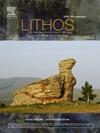安那托利亚中东部同时期钙碱性、阿达基质和超古生代始新世岩浆活动:对该地区同时期至后碰撞构造的启示
IF 2.5
2区 地球科学
Q2 GEOCHEMISTRY & GEOPHYSICS
引用次数: 0
摘要
安纳托利亚中东部地区包括广泛的同碰撞后的古新世至始新世岩浆岩。在区域尺度上,这些岩石可分为(1)碰撞后始新世岩浆岩,主要发育在彭泰兹地区;(2)与İzmir-Ankara和Inner Tauride缝合带发育的前陆盆地相关的同-碰撞后古新世-始新世岩浆岩;(3)与马登盆地东南部相关的始新世岩浆岩。(4)始新世花岗岩类岩体和火山岩的小露头沿锡瓦斯和马拉提亚地区呈北-南走向发育,这是本研究的主要范围。在本研究中,我们重点研究了(2)和(4)群岩石。锡瓦斯和马拉提亚之间始新世岩浆岩包括:(1)俯冲变质地幔源的玄武岩火山岩和辉长岩-闪长岩,(2)通过晶体分选和混合作用与玄武岩岩浆分异的安山岩,(3)可能与基性底板有关的下地壳岩性熔融形成的阿达基流纹岩。玄武岩来源于枯竭岩石圈地幔源的浅层熔融,由俯冲相关成分交代。这种北-南向始新世岩浆活动可能起源于上板块转换断层相关变形所继承的软弱带,这与晚白垩世Baskil-Hınıs弧西缘的俯冲-转换边缘传播器(STEP)断裂有关。而在Inner Tauride缝合带Ulukışla和Sivas盆地暴露的始新世超古生代岩石则是由软流圈贡献的更肥沃、更深的地幔源形成的,这些岩石可能受到晚白垩世大陆俯冲作用的严重污染。这种岩浆活动与最近一次白垩纪碰撞后不久发生的板块断裂过程有关。本文章由计算机程序翻译,如有差异,请以英文原文为准。
Coeval calcalkaline, adakitic, and ultrapotassic Eocene magmatism in Central-Eastern Anatolia: Implications for the syn- to post-collisional tectonics in the region
The central-eastern Anatolian region includes a wide range of syn- to post-collisional Paleocene to Eocene magmatic rocks. On a regional scale, these rocks are here grouped as (1) the post-collisional Eocene magmatic rocks that occur along the Pontides, (2) the syn- to post-collisional Paleocene-Eocene magmatic rocks associated with the foreland basins developed along the İzmir-Ankara and Inner Tauride suture zones, (3) the Eocene magmatic rocks associated with the Maden Basin to the southeast, (4) the small outcrops of Eocene granitoid plutons and volcanic rocks developed in an N-S trend along the Sivas and Malatya regions which is the main scope of this study. In this study, we focused on the (2) and (4) group rocks.
The Eocene magmatic rocks between the Sivas and Malatya comprise (1) basaltic volcanics and gabbroic to dioritic plutons derived from subduction-modified mantle sources, (2) andesitic rocks that have differentiated from the basaltic magmas via crystal fractionation and mixing processes, (3) adakitic rhyolites produced by the melting of lower crustal lithologies possibly in response tobasic underplating. The basaltic rocks were derived from the shallow melting of depleted lithospheric mantle sources, which were metasomatised by subduction-related components. This N-S trending Eocene magmatism may have originated from a zone of weakness inherited from the transform fault-related deformations in the upper plate, which was related to the Subduction-Transform Edge Propagator (STEP) faulting at the western margin of the Late Cretaceous Baskil-Hınıs arc.
The Eocene ultrapotassic rocks exposed in the Ulukışla and Sivas basins along the Inner Tauride suture zone, however, were derived from more fertile and deeper mantle sources with contributions from the asthenosphere, which have been highly contaminated by subduction-related processes, possibly by the Late Cretaceous continental subduction. This magmatic activity was related to slab-break-off processes developed shortly after the latest Cretaceous collision.
求助全文
通过发布文献求助,成功后即可免费获取论文全文。
去求助
来源期刊

Lithos
地学-地球化学与地球物理
CiteScore
6.80
自引率
11.40%
发文量
286
审稿时长
3.5 months
期刊介绍:
Lithos publishes original research papers on the petrology, geochemistry and petrogenesis of igneous and metamorphic rocks. Papers on mineralogy/mineral physics related to petrology and petrogenetic problems are also welcomed.
 求助内容:
求助内容: 应助结果提醒方式:
应助结果提醒方式:


